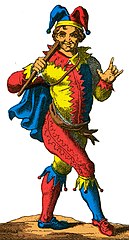
Every month comes with unique events and symbols, but April is the only month associated with fools, i.e., those people who are easily deceived, or unable to accept facts. Most people do not see themselves as fools, which may be why Mark Twain pointed out in his usual succinct way, April 1 is the day upon which we are reminded of what we are on the other three hundred and sixty-four.

The Original Court Fool
Historically, court fools were unique individuals who provided entertainment during long, medieval nights. They played music and told stories. They told sarcastic jokes about their hosts with no repercussions. In fact, the court fool often delivered news a king did not want to hear. In 1634, for example, when the English destroyed the French fleet at the Battle of Sluys, Phillippe VI’s jester announced that English sailors didn’t have the guts to jump into the water like our brave French.
April Fools

An April Fool, however, is a different sort of entertainment. Before 1582, French people celebrated New Year’s Day on April 1, preceded by a eight days of entertainments. That changed in 1582 when Pope Gregory XIII promulgated the new Gregorian calendar and moved the first day of the new year to January 1, where it remains.
News traveled slowly in the 16th century. People in cosmopolitan areas made the change while those living in the country didn’t know about it. And some people heard about the new calendar and refused to switch dates.
These “traditionalists” were ridiculed as gullible April Fools or poisson d’avril, the young fish that were easily caught. Pranksters attach the picture of a fish onto their victim’s back.
Harvesting Spaghetti in Switzerland
Over time April 1 devolved into a day of pranks. In 1957, producers of BBC news program Panorama convinced their audience that spaghetti came from Spaghetti Trees in Italy and Switzerland. “The last two weeks in March,” respected reporter Richard Dimbleby said, “are an anxious time for the spaghetti farmer. There’s always the chance of a late frost which, while not entirely ruining the crop, generally impairs the flavor.”
Many viewers wanted to know where they could purchase a spaghetti tree. The BBC recommending placing a sprig of spaghetti in a tin of tomato sauce and hoping for the best. I wonder how long people watched their “gardens” before giving up.
Spaghetti Trees in Northern California

According to Robert Couse-Baker, Swiss-Italians who settled in the San Francisco Bay Area brought vine stock of spaghetti trees from Lake Lugano, and the tree shown was first planted in the 1890s in Sonoma County. I’m not saying Couse-Baker’s story is a prank, but I’ve yet to see pasta fresh from a Spaghetti Tree offered anywhere. And that’s a shame, because what could be more delightful than spaghetti, fresh from the tree?

Sandra’s Books: Ambition, Arrogance & Pride. Saxon Heroines. Two Coins. Rama’s Labyrinth.
Illustrations & A Few Sources
April drawing by Eugene Grassett, 1796; Troccas-Karte der Narr (Vordergrundextraktion); Petit garçon de 6 ans et demi “victime” d’un poisson d’avril, le 1er avril 2018 by Benoît Prieur; Spaghetti Tree Harvest in Northern California by Robert Couse-Baker; Spaghetti with Parsley by Bairuilong. Michael Bartiromo. “Greatest April Fools’ Prank of all time?” Fox59. Apr 1 2024. Jeff Dean. “April Fools’ Day might be the world’s longest-running joke. No one knows how it began.” NPR. Apr 1 2023.

Sandra Wagner-Wright holds the doctoral degree in history and taught women’s and global history at the University of Hawai`i. Sandra travels for her research, most recently to Salem, Massachusetts, the setting of her new Salem Stories series. She also enjoys traveling for new experiences. Recent trips include Antarctica and a river cruise on the Rhine from Amsterdam to Basel.
Sandra particularly likes writing about strong women who make a difference. She lives in Hilo, Hawai`i with her family and writes a blog relating to history, travel, and the idiosyncrasies of life.

